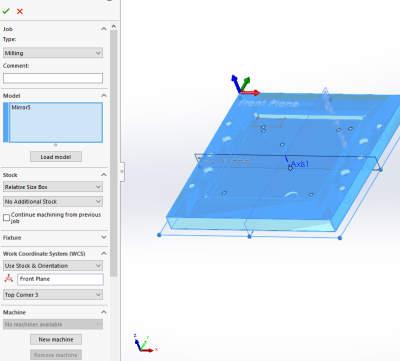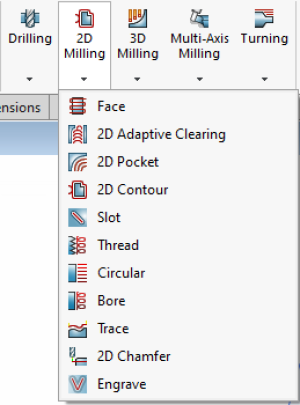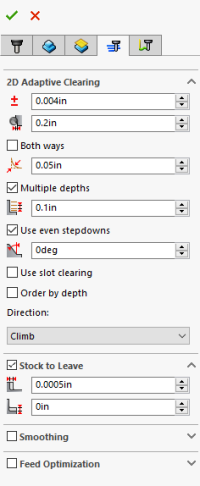This is an old revision of the document!
Table of Contents
Carbide 3D Training SOP
Last edited: Furst (09/08/20)
Instructor:
Date:
| Name | Group or Company | Signature | |
|---|---|---|---|
| 1 | |||
| 2 | |||
| 3 | |||
| 4 | |||
| 5 | |||
| 6 |
Overview:
- This training provides an introduction to using and operating the Carbide 3D Desktop CNC including:
- Software
- Carbide Motion
- Carbide Create
- Solidworks
- HSM Works
- File Types
- G-Code
- .EGC
- Choosing tools and related feeds/speeds
- Setting up a job
- Machine Limitations
- Machine Maintenance
Safety
- Safety Glasses must be worn when machine is running
- The acrylic shield must be in place and lowered before starting a job
- The spindle must be completely stopped before adjusting or removing work piece
- After milling is completed, the work piece will have developed sharp burrs which must be removed with a hand file or sandpaper
Software
CAD:
Carbide 3D makes a rudimentary design software called Carbide Create which can be used to create basic designs; however, Solidworks offers a much more robust features set do create complex and easily modifiable 3D models. This SOP assumes a base knowledge of Solidworks and assumes the user has taken ME-12S or has comparable machining knowledge.
CAM:
Once the design is complete Carbide Create can be used to create the toolpaths, however this SOP will use HSM Works due to its integration with Solidworks and more complex feature set. HSM Works is installed on any Innovations Workshop computer running Solidworks 2020 including the Ultimaker and Carbide 3D computers. many toolpaths will likely be necessary to create the CAM nessesary to machine the part. To generate the toolpaths:
- The Command Window will now show HSM Works functions
- Select “New Job” to specify desired part to machine, define size of raw stock, and indicate the part zero and work holding coordinate system.

-
- 2D and 3D operations require many of the same input perimeters including
-
- Tools can be selected from the “all” category of the tool library based on desired tool and modified using the edit button if necessary to set number of flutes and sickout /geometry of tool and tool holder
- Selecting a tool automatically generates generic feeds and speeds for a much more ridged machining center. Feeds and speeds should be set based on the provided chart under references
- Desired machining geometry
- Simply select the desired face or feature to machine in the current operation.Toggling off Z propagation and tangent propagation can be used to select smaller or partial features.
- If this operation is finishing machining a feature based on the previous operation check “rest machining” and input the second tools diameter
- Cutting/retract heights
- Typically selecting machining geometry will set many of the heights automatically, however they can all be altered if necessary
- Machining passes
-
- Part of feeds and speeds, HSM Works will auto fill many of the boxes, however due to the limited power and rigidity of the machine, stepdowns should be reduced based on the reference material and “multiple passes” should be used to reduce cutter load
- “Material to leave” can be adjusted to create roughing passes if desired. Many operations such as adaptive clearing will automatically leave stock as it is assumed to be roughing operations.
- Linking
- Linking moves dictate how the cutter enters and exits the workpiece and can be altered to prevent the cutter from running into the stock while it attempts to start or finish a cut cleanly.
- Posting
- Post the code by selecting Post Process and selecting Carbide 3D (grbl) as the post configuration. The program name or number should be numbers only, and is typically notated 00001 (not necessary for carbide but good practice for larger machines) make sure to select the desired output folder as by default Solidworks buries the G-code
====Setting up the Carbide for a Job:====
The Carbide router uses fun sized ER11 collets to hold tools from 1 mm to 7 mm but typically uses tools with a 1/8 inch shank.
Changing tools:
- Turn the router off and using an acid brush remove metal shavings and any dust from the tool head
- Using the 17 mm box wrench on the collet nut and the 12 mm open ended wrench on the spindle shaft flats loosen the collet and tool.
- Unscrewing the nut all the way allows the collet and tool to be removed from the spindle and changed out with a different tool of the same shank or with a different sized collet.
- Separating the collet from the collet nut can be done by pushing on the back end of the collet so that it becomes angled within the retaining collet nut and then can be pulled out.
- Before reinstalling the new collet and tool, wipe down the tool shank as well as the collet and spindle tapper.
Homing and Zeroing the machine:
- With the tool installed, make sure the bed is empty and the cover is closed before turning on the machine
- Launch Carbide Motion on the Carbide computer
- Under “Jog” select “Home Machine” and allow machine to home
- Select “measure tool” and the machine will use the automatic tool length measuring tool to zero out the tool
- Next while still under “Jog” position the tool on the work piece zero and zero out the machine by pressing “zero”
Starting Job:
- Load the desired G-code using the “Load” page
- Zero out the machine to match part zero
- Start Job
Machine Limitations
- Each tool change should be accompanied by a new job within HSM Works
- Tool shank diameter is limited to 7 mm
- Max stepdown is limited to .01“ in metal and .04” in wood
- Work area is limited to 8“ x 8” x 4“ x,y,z
Choosing tools
Many tools are optimized for different materials, and although a 2 flute endmill can do most operations, it is not always ideal. Single and duel high helix endmills are available for plastics, woods, and composits, with carbide endmills and burs available for abrasive materials such as glass fiber reinforced materials such as circuit boards. nomad_feeds_and_speeds.pdf
Ultimaker 3 Quick Review
Tool Lead: Andrew Furst
Contact: Andrewfurst@ucsb.edu
Safety Concerns
- Both print heads and bed are heated during operation. Do not attempt to clean, remove, or adjust without allowing for adequate cool down time.
- Keep hands clear of printer during operation. Pause print before clearing or adjusting print.
Safe Operating Procedures Review
- Launch Cura version 4 (blue icon)
- From connected printers, select IW-Ultimaker3
- Select File → Open Files → Open desired project (.STL file type)
- Using task bar on the left hand side, position model as desired
- From print settings, select slice height, infill percentage, and support
- Support can be generated using ether nozzle, typically nozzle one holds build material with nozzle two printing with dissolvable support material.
- Setting can be fined tuned using the “Custom” option from print settings
- Within custom settings, nozzle and build plate temps can be adjusted (build plate temps should be based off of build material)
- Save the file from Cura on a thumb drive
- Connect thumb drive to printer → select desired file → select print
Note: Adjusting settings may lead to more (OR LESS) successful prints. Contact Workshop Wizard responsible for Ultimaker if print fails or knowledge of advanced settings is desired.
Post Processing
- If support was constructed from ABS carefully break away with pliers
- If support was constructed from PVA soak part in warm water for several hours to dissolve support structure
Maintenance
- Bed should be cleaned with IPA between prints
- Print heads and silicone head protector should be cleaned as needed
- Filament should be dried before use if printer has been idle for several weeks
- Bed leveling should be completed every time print cores are swapped
- Print cores should be swapped or purged after clog or to change print line width. Used print heads should be kept for spare parts







